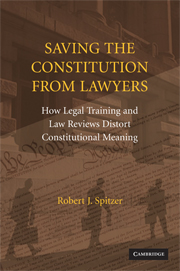 Saving the Constitution from Lawyers
Saving the Constitution from Lawyers 1 - The Logic, and Illogic, of Law
Published online by Cambridge University Press: 05 June 2012
Summary
“It is not what a lawyer tells me I may do; but what humanity, reason, and justice tell me I ought to do.”
Edmund Burke, “Speech On Conciliation With America” March 22, 17751. In an interview with reporters on July 25, 1989, President George H. W. Bush disclosed an eyebrow-raising decision: it was his intention, he said, to exercise a selective or item veto over some piece of legislation if the appropriate circumstance arose where he believed that some provision of an otherwise acceptable bill merited such an action. This pronouncement by the first President Bush was startling for two reasons: first, no other president in American history had ever claimed to possess, much less attempted to exercise, an item veto under the terms of the veto power's description in the Constitution (although many presidents have asked that the power be given to the president); and second, no legal or constitutional change in the president's power had been made to accommodate an item veto.
2. Two weeks after the devastating attacks by terrorists against American targets, launched on September 11, 2001, the Deputy Assistant Attorney General in the Office of Legal Counsel, John Yoo, authored a lengthy memorandum in which he staked out an unprecedentedly sweeping, even grandiose definition of President George W. Bush's powers pertaining to military actions against other nations and terrorist groups.
- Type
- Chapter
- Information
- Saving the Constitution from LawyersHow Legal Training and Law Reviews Distort Constitutional Meaning, pp. 9 - 32Publisher: Cambridge University PressPrint publication year: 2008


